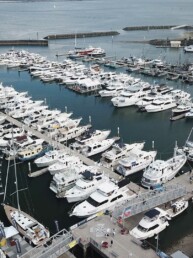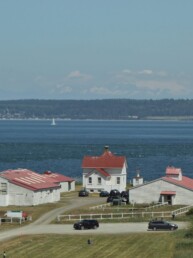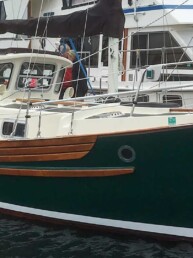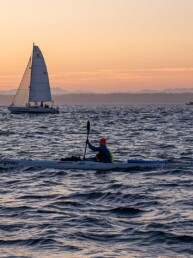Now in it’s 12th year and taking place on January 31, Women’s Day at the Seattle Boat Show featured the all-day Boat University course designed specifically for female boaters. There were also free seminars with numerous female presenters and the day culminated in the Northwest Women in Boating (NWWB) panel featuring five women with diverse boating backgrounds and inspirational insights.
Read about the sold-out Women: Dock, Diesel, Navigate, Crew Overboard course taught by Capt. Margaret Pommert and Capt. Linda Lewis here. Below is a recap of the five fascinating female boaters on this year’s NWWB panel.
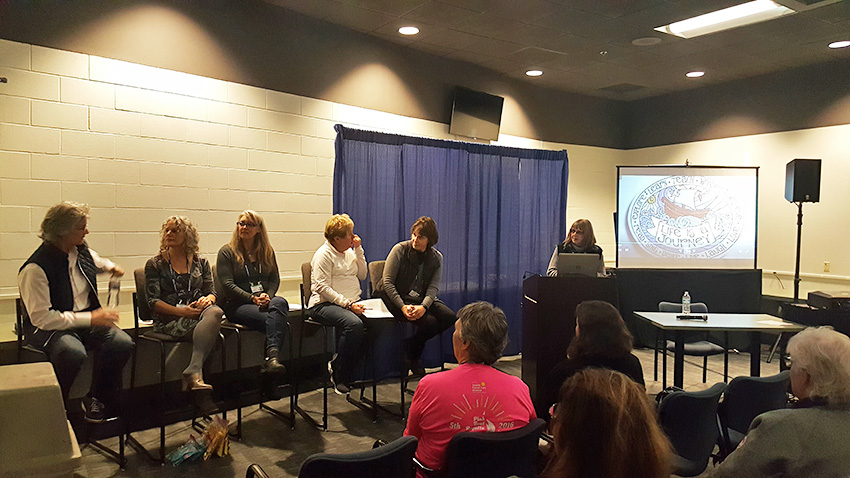
This Women’s Day concluded with Boating – Beyond Fun, Set Off On An Internal Journey, a panel presented by Northwest Women in Boating (NWWB) which is a dues-free organization to connect “women who boat.” In addition to monthly meetings in Seattle, NWWB hosts an online forum and participates in maritime events such as the Seattle Boat Show.
Kicking things off, NWWB co-founder Vivian Strolis presented the 2018 NWWB Award to Elsie Hulsizer, a writer and photographer who has been to the westside of Vancouver Island 23 times. The award recognizes a Northwest woman who has “encouraged, been a role model for, taught and/or inspired women who boat.” Introduced in 2015, past honorees include Judy Nasmith, Linda Lewis, and Lynne Reister.
Marilyn Michael, another NWWB co-founder, welcomed everyone by sharing a short story from her own rocky start in boating.
“We bought a 27’ fiberglass sloop,” Michael explained. “Diligently taking the Coast Guard Auxiliary class, we couldn’t wait to head up to the glorious San Juans, which we did BEFORE we’d learned to sail it.”
Of course, something went awry with their engine. Chuckles in the audience grew to outright laughter as Michael continued, “My husband read aloud from a book on sailing theory while I went forward and managed to hoist the sails and get us underway.”
Michael described how the challenge and adversity of that memorable experience empowered her in a whole new way. Ever since, she’s grown to appreciate how boating can stretch an individual “in ways that few other activities can.”
“If you boat, you’ve had to stretch yourself,” Michael said. “You’ve had to learn new things, you’ve had to respond under pressure at times. Remember those times; remember the feelings you had after handling those situations.”
Michael’s remarks set the stage for a panel as much about the mental challenge of boating as the technical challenges. Read her full remarks here.
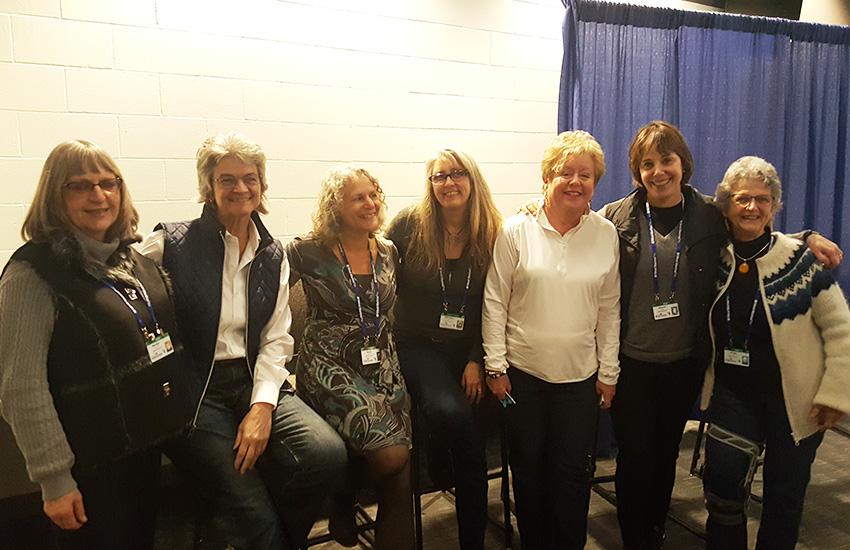
Joanne Poggetti, Owner of a 48’ SeaRay and “dinghy cruiser”
The first panelist, Joanne Poggetti, brought energy and enthusiasm to the podium. Her journey into boating began with a scenario that may sound eerily familiar to other women.
“My husband told me he was going to the boat show,” she started, rolling her eyes. “Just to look, he said.”
Within a few years, they’d not only become boat owners but they’d also upgraded to a larger boat. Yet, the most exciting part for Poggetti was something rather small.
Despite the comforts of cruising on their 48-foot SeaRay, she took to bombing around in the 13’ foot Boston Whaler with a 40hp engine that typically rides shotgun. Eventually, her husband suggested she drive the Whaler a ways back from Roche Harbor since she enjoyed it so much. 50 nautical miles later, Poggetti had fallen in love with what she now calls, “dinghy cruising.”
Before long the larger boat became the “dinghy delivery system” and now, the Boston Whaler is her go-to for outings and even overnights.
“It’s the best,” Poggetti said. “There are no broken water pumps or anything like that. It’s simple.”
She’s gone over to Bainbridge for lunch, taken day trips to Poulsbo and Vashon or gone “orca-prowling”(staying the appropriate distance away, of course).
For overnights, it sounds like any other Puget Sound cruising guide: Blake Island, South Sound, Case Inlet, Jarrell’s Cove, almost anywhere that is protected. Just pack your sleeping bag and use a dry bag. However, the minimalist nature of “dinghy cruising” doesn’t allow for minimalist plans.
“Make sure you do your planning,” Poggetti urged, demonstrating the hundreds of nautical miles of experience she’s gained since her husband’s first boat show. “Really check your weather, it’s good boating anyway, but you’re really exposed.”
It sounds like with the right amount of preparation, safety precautions, dry gear and enthusiasm, you can cruise just about anywhere in a 13’ vessel. Whether on small or large vessels, Poggetti had a few “lessons learned” to share:
- Sexism is still alive and well in boating.
- Develop systems and document best procedures. It takes away stress.
- Having two people who know what to do is important for safety.
- Plan your trips.
- Continue to learn and have fun, it’s not that hard.
How many “dinghy cruisers” will be in the crowd at Women’s Day next time?
 Diane Lander, International Rear Commodore of the Classic Yacht Association
Diane Lander, International Rear Commodore of the Classic Yacht Association
Diane Lander took the stage under the mantle of her “first” boat, the 97-foot 1929 M/V Olympus she purchased with her late husband in 1994. The classic yacht typically had a crew of four and spent many winters in Port Townsend for maintenance.
In 2009, Lander’s husband passed away suddenly and all 97 feet, and everything that accompanied that, became her full responsibility. Managing maintenance, the crew and the vessel’s scheduled was a full-time job. She continued to own and operate the Olympus until 2017 when the retired family law attorney decided it was time for a real retirement. However, things got a little bit exciting before then.
While still owner of the Olympus, Lander purchase another vessel, just for her. In 2014 she acquired a smaller classic yacht called Marian II. Built in 1928, the 42-foot motor vessel was certainly a downsize from the Olympus but presented many new learning opportunities for Lander.
After buying Marian II, Lander couldn’t sleep and she claims it wasn’t because she owned two classic boats at once. Confused, as she’d never before been an insomniac, it finally occurred to her: “I was terrified of running this boat alone and being the sole decision maker,” she told the audience.
Lander describes herself as normally fearless, especially after her law career, so she asked herself, “why am I so fearful?” The short answer: “I was afraid of putting down my wine glass and learning how to drive the boat myself.”
After over 20 years on a crewed vessel, Lander knew how to manage the schedule, maintenance and operational details. However, she had learned only a little about navigation and no longer had someone to bounce ideas around with or a crew to support her.
With Marian II, she had to learn how to operate the boat on her own, navigate, anchor, and direct her guests to help. It wasn’t without effort, though.
“I highly recommend education,” Lander said to a ripple of laughter. “As time progressed, I lapped up every navigation and docking class that I could get my hands on. It seemed the more I knew, the less scary it was.”
Since taking the helm of Marian II, Lander has traveled to the Gulf Islands, won “Best Classic Powerboat” at the Victoria Classic Boat Festival, and cruised throughout the Puget Sound. After all of these cruises, plus lot of docking practice, Lander says, “I’ve learned fear can be overcome by knowledge.”
Concluding, Lander urged the audience, “I would encourage all of you to take the helm, learn how to do it, and do it. Because it’s the most empowering experience I’ve ever had.”
 Christine Smith, Chef and naturalist of M/V David B and author of More Faster Backwards
Christine Smith, Chef and naturalist of M/V David B and author of More Faster Backwards
Christine Smith didn’t know much about boats; which is often the case for new boat owners. The difference for Smith and her husband is: they had a dream. Smith opened by painting a picture of her life now that they’ve achieved that dream.
“I’m the only one up,” she started. “My job is a combination of naturalist, deckhand and junior engineer aboard the David B.” The setting is Glacier Bay, Alaska, and her only company in early morning are glaciers, peaks and ice flows.
Smith described being drawn to nature by her grandparents, to photography by her parents, and to the charter boat business by her husband, Jeffrey. Smith has also been inspired to be strong and unafraid of machinery by her aunt, who operated her own dump truck in a traditionally male-dominated industry.
“Jeffrey and I decided that the best way for two people without much money to get into the business, would be to find an inexpensive old boat to rebuild,” Smith explained. A knowing roar of laughter rose through the audience.
In 1998, they bought the M/V David B, which was built in 1929. Through Smith’s fresh eyes, it looked like it only needed cosmetic work but the next 8 years would prove otherwise. The couples’ pursuit of a dream would not only be a journey to rejuvenate the boat but redefine Smith’s knowledge and expertise.
She took a woodworking class, read books on wooden boats, boat construction, boat fasteners, “boat everything.” Sometimes the knowledge would stick, other times it wouldn’t. There were moments when Smith would realize she knew an answer or what some term meant, when she wouldn’t have before. These exciting moments reminded her how far she’d come.
In 2001, the David B still a work-in-progress, Smith took a step away from land, a step forward, securing a deckhand job on a passenger boat.
“Even though I was planning to operate my own boat, I hadn’t actually spent any time on the water,” she explained.
Working as a deckhand re-inspired Smith and she and Jeffrey worked harder than ever towards their dream. In 2006, they officially started their charter business and everything went smoothly for the first three years. Dream come true? Not quite.
In the winter of 2008, they made a mistake that threatened to overshadow their successes. While winterizing David B, they didn’t double check that all the water was drained from the engine’s cooling system. When they checked on the boat after a cold spell they discovered each cylinder barrel of the 1929 engine, original to the boat and made by Washington Iron Works, was cracked.
In the moment, Smith describes being incredibly overwhelmed. Her “dream come true” might end too soon but her winding journey into boating equipped her to conquer this challenge like all the rest.
“I took the freezing of the engine as an opportunity to learn,” Smith said smiling, the cracked cylinders now a memory. “I told myself, ‘It’ll be a great time to learn about the engine!”
Diving in headfirst, Smith touched every single part that came off the engine. She cleaned, drilled holes, and learned the 1929 engine inside and out. By the end of winter, David B’s engine was repaired and the dream resumed.
The next challenge Smith chose was to sit for her 100-ton Coast Guard Master’s License. She had the experience but felt intimidated as the only female in the class and had always struggled with math. Again, her resolve shone through.
“I love learning!” Smith told the audience. “Through my willingness to learn, I’ve been able to create my perfect job and do what I want. Learning has opened so many doors for me and conquered obstacles of all magnitudes.”
Now, Smith is a naturalist, a chef, a photographer, a published author, a ship’s engineer, and a captain living life on the water. Her drive has delivered, and she enjoys many scenes such as the one she describe on the water in Alaska.
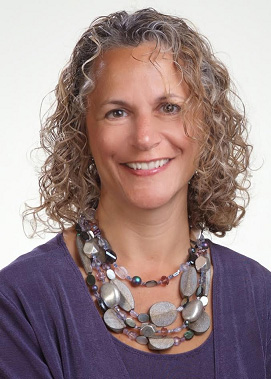 Dana Greyson, Sales Manager at West Marine and freelance writer, galleywenchtales.com
Dana Greyson, Sales Manager at West Marine and freelance writer, galleywenchtales.com
Arriving at the podium, Dana Greyson began with a keen observation: “I’m going to start with my husband’s story. It seems like even though we’re all here talking about women, so far most of us seem to talk about how it started with a man.”
Greyson’s boating life began when her husband took a job at Boeing and “was miserable.” Although he was well-compensated, he worked long hours and didn’t have much to do outside of work. He discovered the idea of sailing around the world, an escape, and introduced Greyson to the idea.
Open to it, but an inexperienced boater herself, she watched as he continued to struggle in his life in Everett. He pushed for an earlier and earlier departure date until she said, “Will you just go buy a boat already?!”
Prioritizing safety and price, they purchased a boat 36.5-foot Pearson 365 ketch in St. Lucia less than a year and a half after Greyson’s husband introduced the idea. The short timeline reflected the struggle that Greyson and her husband faced in their lives and the trust they had in each other to take a leap. When they left for St. Lucia, they had reduced their possessions to 5 boxes in a relative’s garage and the maximum they were allowed in checked baggage.
“I envy and admire these amazing women who have gone off and done this from my perspective, ‘the right way’, and actually learned what they’re doing,” Greyson said. “I didn’t.”
In the five years that followed, Greyson and her husband cruised 20,000 miles, visiting 30 countries and completed their plan to sail to Australia and sell their boat down under. Along the way they hit squalls, redefined “hygiene”, battled bugs, avoided sharks, and enjoyed the culture and cuisine they encountered.
A big takeaway for Greyson was seeking support in the community you want to be a part of: “If you really want to do something, go for the people who are doing it, not all the people who give you all the reasons you don’t do it,” she said.
Now back in the Pacific Northwest, Greyson and her husband are back on a boat setting a new course and aren’t sure what their next adventure will be.
Reflecting on the experience as a whole Greyson said, “I learned to let go, I learned to have less stuff, I learned to get rid of my fifth kayak and my sixth kayak…It’s going to be o.k. I don’t know what the future is, but life is a journey.”
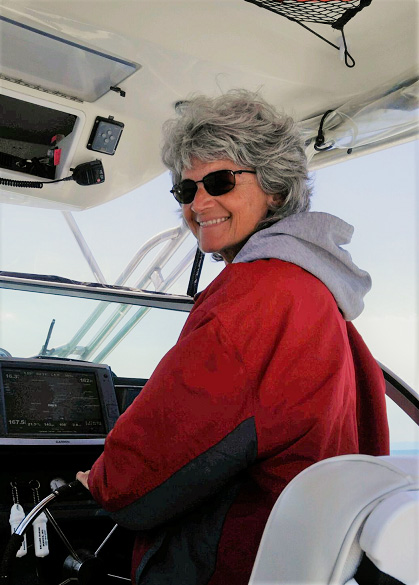 Carol Castellani, SPD Officer
Carol Castellani, SPD Officer
Carol Castellani, who has served on the Seattle police force for 35 years, is undoubtedly an adventurer. She’s rowed 275 miles on the Colorado River, climbed mountains in South America, and toured by motorcycle in the Arctic. And that doesn’t even include her experiences in Pacific Northwest waters.
Focusing on the internal journey that boating and her career have provided her, Castellani told the audience, “I don’t think I’m exceptionally gifted but what I have is a sense of curiosity.”
That curiosity propelled Castellani to explore the Grand Canyon, the Arctic Tundra, the Andes, and even into the assignments she’s received throughout her career.
At crossroads, Castellani often asks herself, “I wonder if I can? I wonder if I can?”
That question led Castellani to be the first woman in the canine division, the second woman to ride a parade on a police motorcycle, and, in her favorite assignment, the only female officer during her 10 years in Harbor Patrol.
Harbor Patrol wears more hats than many people realize. The unit serves as marine firefighters, dive medics, EMTs, dive masters, and a crucial safety resource for the public. Castellani continued to educate and train, completing additional certifications including becoming a dive medic and a NOAA certified diver.
Internally, she created code for herself, “Carol’s High C’s” which are: Curiosity, Challenge, Courage, and Confidence.
“When we’re curious, we think beyond ourselves” Castellani explained. “The challenge is turning that curiosity into action.” She continued describing that accepting that challenge and leaving a comfortable place sets a course for change.
Next up, courage. With an exasperated sigh Castellani said, “I have heard…that courage is being fearless. In my 37 years of law enforcement and the crazy, off-the-wall adventures I’ve had, I’ve felt fear.”
When people are afraid, Castellani sees two choices. First, they can choose courage or they can choose self-doubt.
“How does self-doubt serve anybody?” Castellani asked. “How does self-doubt help the situation at hand? I urged you to choose courage.”
And the final “C”, which is exceptionally challenging in new situations, is confidence.
“As we realize our positive effect with the decisions we make and the challenges we accept, those little confidence builders start to grow” Castellani said.
Castellani did not grow up on the water, she was raised on a dairy farm. Coming to the Puget Sound region and eventually joining the Harbor Patrol compounded the new situations she encountered.
“Imagine a cadre of men, I’m the only woman in the harbor patrol,” Castellani remembered, “and they’re all teaching me to tie a bowline. Talk about some pressure!”
How did she succeed? Confidence. Trying again after ever little victory and failure got her there.
“Carol’s High C’s” and her dedication to continuing medic training all came together for Castellani one year during SeaFair. Every August, boaters take over the waterways for a giant tailgate party and often sacrifice safety in favor of over-consumption.
Committed to her duty, Castellani and her partner heard screaming and detected something was not right aboard an idling powerboat. They arrived on scene to find two women injured by the boat’s propeller.
Without hesitation Castellani chose courage. She took control of the scene and provided urgent medical assistance to the victims until help arrived. Both victims survived the traumatic experience preventing a greater tragedy, but this tale reminded boaters in the room of the importance of safety every moment on the water.
“I encourage you, if it comes down to anything: be curious and choose courage for whatever the world may present” Castellani concluded.
Cara Kuhlman is a Seattle-based sailor, writer, and craft beer enthusiast. AND she’s the proud new owner of a Catalina 34.
Cara Kuhlman
Cara Kuhlman is a Seattle based writer, sailor, and craft beer enthusiast. See more of her work at https://carakuhlman.com/


